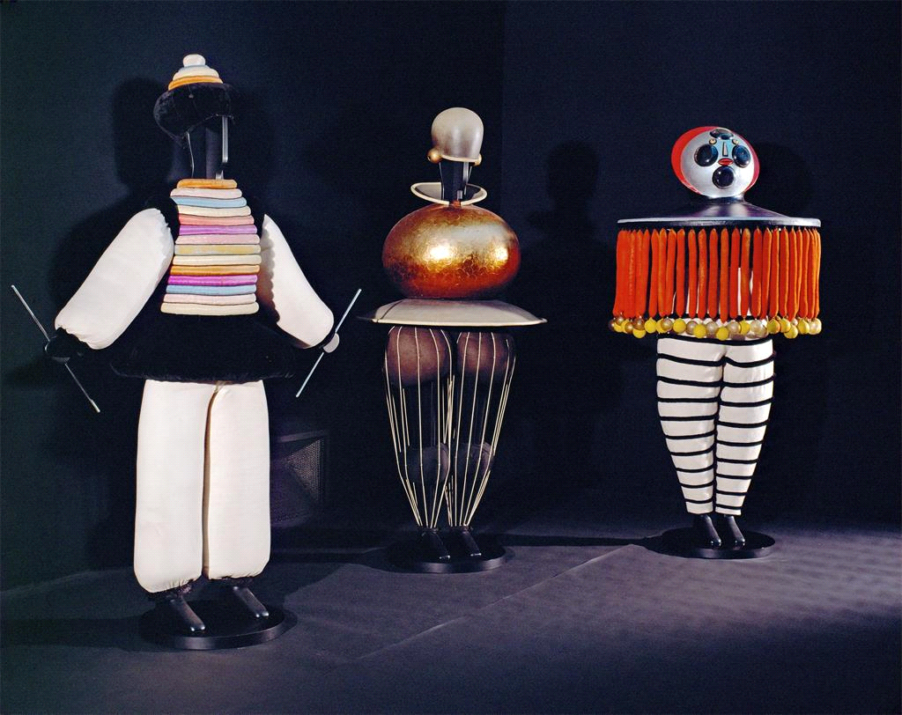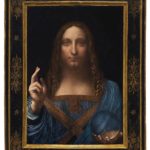At least since the times of Leonardo Da Vinci, artists have tried their hands at designing costumes. The Renaissance master likely intended for his to be used for masquerades or other court festivities. But a number of artists throughout history have developed fruitful relationships with dance companies and choreographers, putting their creative vision in motion. From Leonor Fini’s surreal and scandalous going-out attire to Robert Rauschenberg’s delicate, pointillist leotards, here are seven artists who made their work wearable.
Robert Rauschenberg

Merce Cunningham Company Photographed performing, the back drop painting by Robert Rauschenberg.
Rauschenberg and choreographer Merce Cunningham developed a long-lasting partnership, working together on 24 dances in total. One of these titled Summerspace (1958), featured rainbow-hued pointillist backdrops and leotards—a far cry from the American artist’s typical Neo-Dadaist works. Another significant collaboration performed in 1964,Antic Meet, featured a four-armed sweater worn by Cunningham himself, which required the dancer to switch armholes throughout the performance. “Over time with Rauschenberg, there’re certain motifs that recur,” Walker Art Centercurator Darsie Alexander explained to Art news.“You can see some of his imagery migrate from painting and sculpture into Cunningham’s realm.”
Jeff Koons

Jeff Koons, inflatable Pig Costume Polyvinyl figure with battery driven inflation motor.
Choreographer and “punk ballerina” Karole Armitage fused the worlds of art, dance, fashion, and music in 1988 with a performance titled Go Go Ballerina on New York’s Lower East Side. Jimi Hendrix and Public Enemy were featured on the soundtrack neo-expressionist painter David Salledressed the dancers, and Koons crafted the set pieces. A year later, Koons himself tackled a costume for another Armitage production, this one titled Contempt. The resulting blow-up pig suit, the dancer’s legs poking through its porky belly, offers a prime example of the artist’s long-standing interest in inflatable.
Marc Chagall

The Fire bird: Blue and Yellow Monster
Chagall’s later costumes, for Stravinsky’s ballet. The Firebirdi and Mozart’s opera The Magic Flute, incorporate delicate embroidery and decadent fabrics. But these early designs, for a 1942 performance by the American Ballet Theater, have more in common with his canvases. Each outfit is hand-painted, incorporating themes from Russian folklore alongside traditional Mexican styles. It’s a combination particularly suited to the subject matter: The ballet, Aleko, is based on a poem by Russian writer Alexander Pushkin and premiered in Mexico City.
Isamu Noguchi

The Hamburg Ballet Costumes
Noguchi, with his polished, pared-down sculptural forms, was well-suited to creating set designs for modern dance. He worked frequently with a host of influential American choreographers, including Martha Graham, Merce Cunningham, and George Balanchine. Balanchine in particular, as one of the founders of the New York City Ballet, commissioned Noguchi to create the sets and costumes for the dance company’s inaugural 1948 performance of Orpheus. “There is joy in seeing sculpture come to life on the stage in its own world of timeless time,” Noguchi once remarked of his theater collaborations.
Sonia Delaunay

Drooled over the costumes and sets from the Ballet of Russia
Russian art critic Serge Diaghilev founded the Ballets Russes in 1909, weaving together the talents of major contemporary artists (including Pablo Picasso and Henri Matisse) and composers (such as Igor Stravinsky and Erik Satie) for his innovative productions. In 1917, Diaghilev asked Delaunay—an abstract painter whose works feature whorls of colourful, geometric forms—to make the costumes for his revival of Cléopâtre. The exposure helped to launch her design career, which resulted in a series of popular textiles and costumes for opera, film, and ballet.
Oskar Schlemmer

Tradic Ballet 3-figures
The original Triadic Ballet, which premiered in 1922, was an avant-garde production that fused the spheres of dance, music, theatre, art, and architecture into a mesmerizing whole. Formally trained as a painter and sculptor, Schlemmer embodied the multidisciplinary spirit of the Bauhaus crafting costumes and choreography he. Although that occasionally led to mishaps—the first costumes he made fell apart during an early performance—the work was met with wide acclaim during its 10-year run. Specifics of the choreography and score have been lost to time, although photographs and sketches of the costumes still exist; this 1970 arrangement for video attempted to recreate the original production with sculptural costumes and mechanical choreography.
Leonor Fini

Self Portrait
Fantastical, otherworldly women populate the vibrantly hued paintings of Argentine Surrealist Fini. And the costumes she donned in real life often transformed her into a similarly fantastical character. (“I have always loved, and lived my own theatre,” she once said.) She was known to dye her hair—in shades of blue, red, orange, or gold—and would arrive at events wearing nothing but a cape of white feathers paired with matching white boots. Following World War II, Fini attended a grand total of 16 costume balls over seven years; her spectacular outfits ended up in magazines each time. As her reputation spread, she began receiving costume and set design commissions for ballets, plays, operas—even films, including Federico Fellini’s’81/2(1963) and Renato Castellani’s Romeo and Juliet (1954).



Sneakers Golden Goose Mid Star Uomo Saldi
January 6, 2020I’m amazed, I must say. Rarely do I come across a blog that’s both educative
and engaging, and without a doubt, you have hit the nail
on the head. The problem is something not enough men and women are speaking intelligently about.
I am very happy I came across this in my hunt for something regarding this.